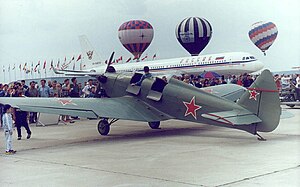Yakovlev UT-2
| UT-2 | |
|---|---|
 |
|
| UT-2 survivor at Monino | |
| Role | Trainer |
| National origin | USSR |
| Manufacturer | Yakovlev |
| Designer | Aleksandr Sergeyevich Yakovlev |
| First flight | 11 July 1937 - Ya-20 |
| Status | retired |
| Primary user | Soviet Air Forces |
| Produced | 1936 to 1948 |
| Number built | 7,243 |
| Developed from | AIR-10, Ya-20 |
| Variants | Yakovlev Yak-5 |
The Yakovlev UT-2 (Russian: Яковлев УТ-2; NATO reporting name "Mink") was a single-engine tandem two-seat low-wing monoplane that was the standard Soviet trainer during the Great Patriotic War. It was used by the Soviet Air Force from 1937 until replaced by the Yakovlev Yak-18 during the 1950s.
The preceding U-2 (Po-2) biplane was no longer a suitable trainer for the faster modern aircraft entering service, and to fill the role, the UT-2 was designed as a trainer.
The new aircraft was designed by Alexander Sergeevich Yakovlev's team at OKB-115. Originally designated AIR-10, it was based upon the AIR-9, but it was simpler, with tandem open cockpits, also omitting slats and flaps. It first flew on 11 July 1935. The AIR-10 won the competition in 1935 and, after minor changes, was accepted as the standard Soviet Air Force trainer. With the disgrace of Alexey Ivanovich Rykov under whom Yakovlev had been working, the initials AIR were replaced with Ya making what would have been the AIR-20 the Ya-20 (Я-20).
The wood-and-metal mixed construction of the AIR-10 was simplified to use only wood to facilitate production, and the AIR-10s 120 hp Renault inline engine was replaced with the 112 kW (150 hp) Shvetsov M-11E radial on the prototype, and the 82 kW (110 hp) M-11Gs in early production aircraft. Serial production started in September 1937. The Soviet VVS (Air Force) assigned the aircraft the designation UT-2 (uchebno-trenirovochnyi {учебно-тренировочный}, trainer).
The UT-2 was not easy to fly and easily entered into spins. The UT-2 model 1940 featured a lengthened forward fuselage, and a change to the 93 kW (125 hp) M-11D radial to attempt to rectify the problem. Despite improvements, the handling and flight characteristics remained challenging.
...
Wikipedia
